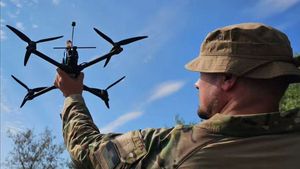JAKARTA - The American National Space Agency (NASA) and the Indian Space Research Organization (ISRO) are working together to build Earth's mapping satellite to provide important information about the earth's crust, ice sheets, and ecosystems.
Dubbed NISAR, shortcoming from NASA-ISRO Synthetic Aperture Radar, the satellite will be launched no later than 2024 into Earth orbit from the Satish Dhawan Space Center in Andhra Pradesh state, India.
NISAR itself is planned to operate for three years, including breakthrough technology that can help understand Earth and overcome natural disasters.
It is the first radar imaging satellite to use double frequency, namely the SAR L-band provided by JPL and S-band SAR made by ISRO. Both have been integrated and tested since 2021 by engineers and technicians on JPL.
With these two radar systems, NISAR will be able to systematically map the Earth's crust at an extraordinary level of detail. He can detect changes below 1 cm.
This will make NISAR observe even the subtle nuances of earthquakes, tsunamis and other disasters. The satellite will also help monitor long-term processes, including the evolution of the earth's crust, ecosystem disruptions, and the collapse of ice sheets.
Measurements of melting of sea ice and ice sheets will increase understanding of the speed and impact of climate change, including sea level rise.
Meanwhile, observations of forest and agricultural areas on the planet will increase knowledge of the carbon exchange between the atmosphere and the plant community, reducing uncertainty in models used to project future climates.
"This marks an important milestone in our journey together to better understand planet Earth and our climate change," said NASA's Director of Jet Propulsion Laboratory (JPL), Laurie Leshin as quoted from NASA's official website, Saturday, February 4.
"By providing measurements with unprecedented precision, the promise of NISAR is a new understanding and a positive impact on society. Our collaboration with ISRO exemplifies what might happen when we address complex challenges together," he added.
In addition, data collected by NISAR will also play an important role, where satellites will offer worldwide coverage every 12 days both day and night, making time-based imagery more practical.
The NISAR mission team hopes that data will be available to the public in one to two days, but if the data emergency conditions are sent within a few hours. Anyone who wants to break down information can take advantage of it.
"Today we are one step closer to fulfilling the enormous scientific potential NASA and ISRO expect for NISAR when we joined more than eight years ago," said ISRO Chairman S. Somanath.
"This mission will be a strong demonstration of radar capabilities as a science tool and help us study Earth's dynamic ground and ice surface in more detail than ever before," he added.
Late this month, they will move SUV-sized payloads into special cargo containers for 9,000-mile flights to India's UR Rao Satellite Center in Bengaluru city. There, NISAR will be combined with a spacecraft bus in preparation for the 2024 launch.
The English, Chinese, Japanese, Arabic, and French versions are automatically generated by the AI. So there may still be inaccuracies in translating, please always see Indonesian as our main language. (system supported by DigitalSiber.id)











